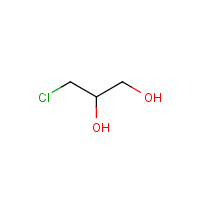alpha-Chlorohydrin
Agent Name
alpha-Chlorohydrin
Alternative Name
3-Monochloro-1,2-propanediol
CAS Number
96-24-2
Formula
C3-H7-Cl-O2
Major Category
Other Classes

Synonyms
Glycerol alpha-monochlorohydrin; 1,2-Dihydroxy-3-chloropropane; 1,2-Propanediol, 3-chloro-; 1-Chloro-1-deoxyglycerol; 1-Chloro-2,3-dihydroxypropane; 1-Chloropropane-2,3-diol; 2,3-Dihydroxypropyl chloride; 3-Chloro-1,2-dihydroxypropane; 3-Chloro-1,2-propanediol; 3-Chloro-1,2-propylene glycol; 3-Chloropropane-1,2-diol; 3-Chloropropanediol; 3-Chloropropylene glycol; Chlorhydrin; Chlorodeoxyglycerol; Chloropropanediol; Epibloc; Glycerin alpha-monochlorhydrin; Glycerin epichlorohydrin; Glycerol 3-chlorohydrin; Glycerol chlorohydrin; Glyceryl alpha-chlorohydrin; Glyceryl chloride; Glyceryl-alpha-chlorohydrin; Monochlorhydrin; Monochlorohydrin; U 5897; U-5897; alpha-Chlorohydrine; beta,beta'-Dihydroxyisopropyl chloride; [ChemIDplus] UN2689
Category
Halogenated Alcohols
Description
Colorless, hygroscopic liquid; [Hawley] Tends to turn straw-colored; [Merck Index] Colorless viscous liquid; [MSDSonline]
Sources/Uses
Used as a rodent chemosterilant, solvent (cellulose acetate, glyceryl phthalate resins, and gums), antifreeze agent for dynamite, and chemical intermediate for dyes and other organic chemicals; [HSDB] Found as a contaminant of acid-hydrolyzed vegetable proteins and soy sauce; [WHO]
Comments
Commercial product is mixture of the alpha and beta isomer; [Hawley] Numerous and severe adverse effects to male reproductive organs and sperm (including infertility) have been observed in rats and other mammals; [HSDB] May cause skin, eye, and mucous membrane irritation; Toxic by inhalation, ingestion, and skin contact; [CAMEO] Causes decreased sperm motility and count in rats at low doses, and testicular pathology at higher doses; [Reference #1] Reversible effect on male fertility by interfering with sperm function; No available information on pregnancy, lactation, or other effects to the female reproductive system; [REPROTOX] Well documented adverse effects to rat male reproductive system and sperm; Observations in intraperitoneal injection studies with rats and mice include lesions of the CNS (especially brain stem); Numerous studies indicate the kidney as the primary target organ for toxicity, with clear evidence of nephrotoxicity in a two year feeding study with rats; May be mutagenic in vitro at very high doses; Non mutagenic in vivo; Caused increase in benign tumor frequency in one study at dose higher than associated with renal tubule hyperplasia; [WHO]
Restricted
Restricted use pesticide in the US; One product registered for use indoors in industrial and commercial structures and in sanitary sewers for control of Norway rats; Not registered for outdoor use or for other rodent species; [Reference #1]
Reference Link #1
Biomedical References
Exposure Assessment
MAK
0.005 ppm
Vapor Pressure
0.2 mm Hg
Lethal Concentration
LCLo (rat) = 125 ppm/4h
Explanatory Notes
Flash point = 145 deg C; [eChemPortal: IUCLID] VP = 3.75 mm Hg; [CAMEO] VP from ChemIDplus;
Reference Link #2
Adverse Effects
Nephrotoxin
Yes
Reproductive Toxin
Yes
IARC Carcinogen
Possible (2b)
Diseases, Processes, and Activities Linked to This Agent
Processes
Industrial Processes with risk of exposure: